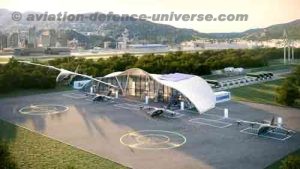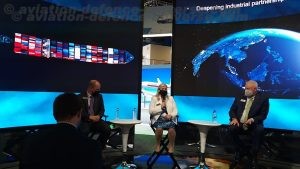
Singapore. 14 February 2022. Rolls-Royce and the Luxaviation Group, a leading luxury jet and helicopter service provider are announcing plans today to collaborate on leading the development and deployment of Advanced Air Mobility (AAM). Rolls-Royce will provide electrification solutions, maintenance support services, and digital solutions for Luxaviation Group’s planned network of vertiports. Luxaviation already has a presence at over 120 VIP terminals across the world. Both companies share a vision of Advanced Air Mobility solutions including all-electric and hybrid-electric vertical take-off and landing as well as fixed-wing commuter aircraft.
The Memorandum of Understanding between Rolls-Royce Electrical, Rolls-Royce Power Systems and Luxaviation focuses on operations, vertiports and surrounding infrastructure to support these exciting new markets that will transform the way we travel. The strategic partnership will look at three main areas:
- Charging and energy infrastructure for vertiports
- Maintenance provision for electric aircraft
- Digital solutions for related applications across AAM
Rob Watson, President of Rolls Royce Electrical said:“Rolls-Royce will be the leading provider of all-electric and hybrid-electric power and propulsion systems for Advanced Air Mobility. As part of our strategy, we are looking to ensure we understand how we can deliver maintenance and services for these new aircraft building on our existing MRO and analytics capabilities. We are delighted to collaborate with Luxaviation who we believe will be a leading player in the AAM industry and that this collaboration will help both partners to be at the forefront of this new market.
“This strategic partnership also leverages capabilities and technology across Rolls-Royce as we develop the electrical power and propulsion systems for eVTOL and commuter aircraft. Rolls-Royce is set to build on our existing network to offer maintenance services for electrical systems. Further, Rolls-Royce Power Systems is able to offer micro grid solutions to support fast-charging of electric aircraft and deliver reliable, cost-effective and climate friendly, sustainable power to vertiports.”
Andreas Schell, CEO Rolls-Royce Power Systems says: “Rolls-Royce will offer integrated solutions from a single source across its business units. Power Systems can already supply climate-friendly micro grids that combine renewable energy sources, battery storage and conventional power generation. Soon we will also offer them with fuel cell generators, hydrogen engines and electrolysers. This is another demonstration of how Rolls-Royce is helping make aviation more sustainable.”
Christophe Lapierre, Luxaviation’s Head of strategy and President Business Aviation Support Services said: “We are convinced that Rolls-Royce and Luxaviation, two market leaders with a global network, talent, expertise, and vision across entire value chain will accelerate the deployment of Advanced Air Mobility through this strategic partnership.
“Our common vision to enable early adoption by leveraging existing capabilities places this partnership at an advanced position, considerably pushing the evolution of this new industry segment. Our concept is to provide a solution that is agile and in continuous evolution to scale up Advanced Air Mobility operations alongside regulatory development pace and market demand.”
With over 60 years of experience in operations, Fixed Based Operator (FBO) passenger services and hundreds of aircraft under management, Luxaviation Group has launched various projects promoting the future of Advanced Air Mobility. The first deliverable of this partnership will be the creation and implementation of a pilot project outlining electrical solutions.
Last year, Rolls-Royce announced a pathway to net zero carbon emissions and its electrical technology is one way in which the company is helping decarbonise critical parts of the global economy. Rolls-Royce is committed to ensuring its new products will be compatible with net zero operation by 2030 and all its products will be compatible with net zero by 2050.































































































































